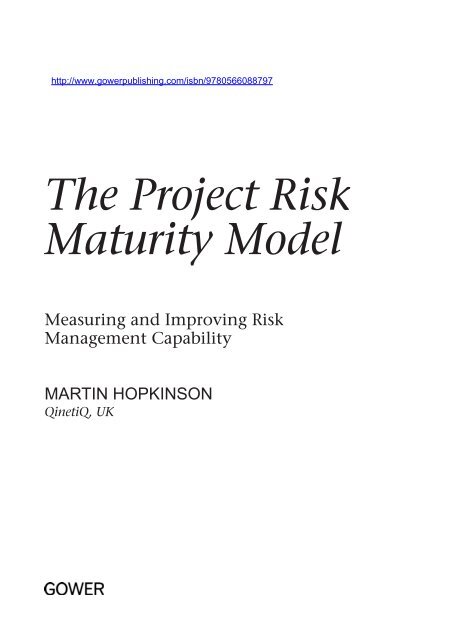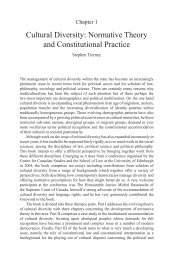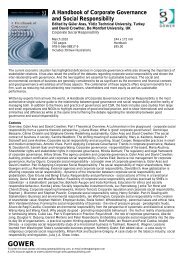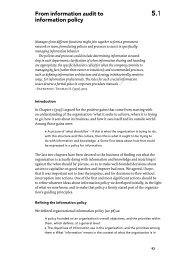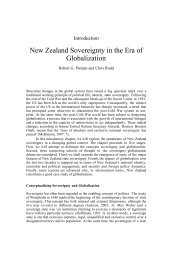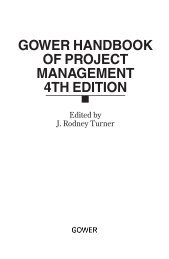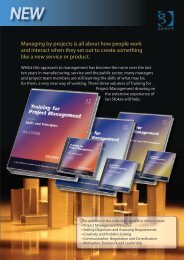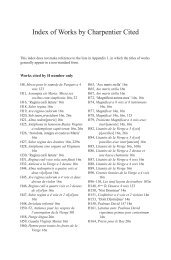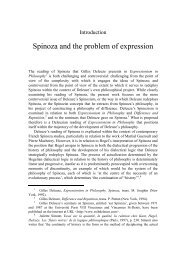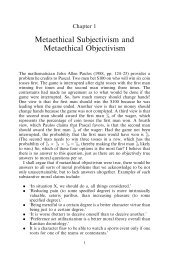The Project Risk Maturity Model
The Project Risk Maturity Model
The Project Risk Maturity Model
Create successful ePaper yourself
Turn your PDF publications into a flip-book with our unique Google optimized e-Paper software.
<strong>The</strong> <strong>Project</strong> <strong>Risk</strong><br />
<strong>Maturity</strong> <strong>Model</strong><br />
Measuring and Improving <strong>Risk</strong><br />
Management Capability<br />
Martin Hopkinson<br />
QinetiQ, UK
chapter<br />
1 <strong>The</strong> <strong>Project</strong> <strong>Risk</strong> <strong>Maturity</strong><br />
<strong>Model</strong><br />
A <strong>Risk</strong> <strong>Maturity</strong> <strong>Model</strong> (RMM) is a tool designed to assess risk management capability. <strong>The</strong><br />
<strong>Project</strong> RMM software provided with this book will allow its user to assess the capability<br />
of the risk management process being applied on any project. It will also allow capability<br />
improvements to be assessed and for the capabilities of different projects to be compared.<br />
However, assessing risk management capability is not a simple task. Obtaining reliable<br />
results requires an assessor (or auditor) who has insight into the subtleties of project risk<br />
management; what is best practice for one project might be inappropriate to another.<br />
This book has been written to describe the issues facing anyone tasked with assessing<br />
project risk management capability. Whilst it is possible for any owner of the <strong>Project</strong><br />
RMM software to load it onto their computer and start their assessment process forthwith,<br />
following the guidance in this book should provide them and their organisation with a<br />
sounder basis for believing the results.<br />
By way of introduction, the rest of this chapter describes how the <strong>Project</strong> RMM<br />
has been constructed and how its results should be interpreted. Subsequent chapters<br />
then describe the issues that assessors should understand before putting the RMM into<br />
action or making recommendations for process improvement. <strong>The</strong> section ‘Software User<br />
Instructions’ at the end of the book (pp. 235–42), provides user instructions for how the<br />
<strong>Project</strong> RMM software should be installed and used.<br />
<strong>The</strong> <strong>Project</strong> <strong>Risk</strong> <strong>Maturity</strong> <strong>Model</strong> (RMM)<br />
<strong>The</strong> <strong>Project</strong> RMM was first developed by HVR Consulting Services in 1999. Its fourlevel<br />
capability structure, illustrated in Figure 1.1 is derived directly from the structure<br />
developed by David Hillson (1997) who used it to establish a generic <strong>Risk</strong> <strong>Maturity</strong><br />
<strong>Model</strong> framework. <strong>The</strong> matrix for assessments identified by Hillson’s paper published in<br />
the International Journal of <strong>Project</strong> and Business <strong>Risk</strong> Management has been reproduced in<br />
Appendix A.<br />
In order to adapt the Hillson <strong>Risk</strong> <strong>Maturity</strong> <strong>Model</strong> for project-specific purposes, the<br />
following additional sources were used:<br />
• Standard risk management guides, most notably the <strong>Project</strong> <strong>Risk</strong> Analysis and Management<br />
(PRAM) Guide (1997) published by the Association for <strong>Project</strong> Management (APM).<br />
• <strong>The</strong> project risk management literature published in academic journals and books.
T h e P r o j e c t R i s k M a t u r i t y M o d e l<br />
Level 4:<br />
Natural<br />
Level 3:<br />
Normalised<br />
Level 2:<br />
Novice<br />
Level 1:<br />
Naive<br />
Figure 1.1<br />
<strong>Risk</strong> maturity model levels<br />
• <strong>The</strong> Turnbull Guidance (1999) – Internal Control: Guidance for Directors on the Combined<br />
Code.<br />
• <strong>The</strong> experience, dating back to 1987, of risk management consultants working for<br />
HVR Consultancy Services.<br />
Since its creation the <strong>Project</strong> RMM has continued to evolve in response to lessons<br />
learned from its application. To date, it has been used for approximately 250 assessments<br />
on projects with an estimated combined value in excess of £60 Billion. Changes have<br />
also been made in response to new literature on the subject. Later chapters in this book<br />
identify the sources that have been the most influential. <strong>The</strong> software on the CD ROM<br />
included with this book is the latest version (version no. 6.0.0) of the model, updated in<br />
2010.<br />
<strong>The</strong> definitions of each level of project risk management capability are:<br />
Level 1 – Naïve<br />
Although a project risk management process may have been initiated, its design or<br />
application is fundamentally flawed. At this level, it is likely that the process does not<br />
add value.<br />
Level 2 – Novice<br />
<strong>The</strong> project risk management process influences decisions taken by the project team in<br />
a way that is likely to lead to improvements in project performance as measured against<br />
N. Turnbull et al., Internal Control: Guidance for Directors on the Combined Code, hereafter referred to as the Turnbull<br />
Guidance or the Turnbull Report.
T h e P r o j e c t R i s k M a t u r i t y M o d e l<br />
<br />
its objectives. However, although the process may add value, weaknesses with either the<br />
process design or its implementation result in significant benefits being unrealised.<br />
Level 3 – Normalised<br />
<strong>The</strong> project risk management process is formalised and implemented systematically.<br />
Value is added by implementing effective management responses to significant sources<br />
of uncertainty that could affect the achievement of project objectives.<br />
Level 4 – Natural<br />
<strong>The</strong> risk management process leads to the selection of risk-efficient strategic choices<br />
when setting project objectives and choosing between options for project solutions or<br />
delivery. Sources of uncertainty that could affect the achievement of project objectives<br />
are managed systematically within the context of a team culture conducive to optimising<br />
project outcomes.<br />
Advancing through <strong>Project</strong> RMM <strong>Maturity</strong> Levels<br />
RMM Level 1 could describe a project that is not implementing any process for managing<br />
risk. This would include projects that claim to be implicitly managing risk by virtue of<br />
the effectiveness of other project management processes such as planning (thus ignoring<br />
the fact that deterministic project management processes such as planning are not<br />
designed to manage the implications of uncertainty). However, since it would be unusual<br />
for projects to undergo RMM assessments when they have no formal risk management<br />
process, the more common cause of RMM Level 1 assessment results is a fundamental<br />
flaw with the design or application of the process. In practice, most problems at this level<br />
amount to failures of application. Whilst a risk management process might have been<br />
initiated, allowing any of its critical components to lapse into disuse will result in the<br />
overall process adding no value, hence producing a Level 1 assessment.<br />
Once a project has taken professional advice or followed standard guidance to initiate<br />
its process, moving to a Level 2 RMM capability should be a relatively easy target to<br />
achieve. Level 2 does not set a particularly demanding standard. In effect, it requires<br />
that the value added by applying the risk management process should be greater than<br />
the cost and other resource implications of its application. Thus, even a relatively light<br />
application of the process can be sufficient to achieve this level.<br />
<strong>The</strong> step-change difference between Level 2 and Level 3 RMM capability is mainly<br />
attributable to two factors: the discipline of implementing the process consistently across<br />
the whole project and the quality with which key skills are applied in practice.<br />
A project will be able to achieve RMM Level 3 with the simple common-practice<br />
approach of using a risk register to underpin routine reviews of the implications of risks<br />
and the effectiveness and implementation of the responses designed to manage them.<br />
Although this is a simple process, there are a number of important skills involved in<br />
exploiting its potential to the full. For example, risks must be understood in a way that<br />
clarifies all relevant and significant sources of uncertainty. Failure to do this will impair<br />
the effectiveness of risk responses. Similarly, there are key skills involved in making sure
T h e P r o j e c t R i s k M a t u r i t y M o d e l<br />
that risk register contains the right risks, (and that they continue to be the right risks),<br />
that they are managed by the right risk owners, and that appropriate and sound methods<br />
are used to select and prioritise risks for review.<br />
Although RMM Level 3 can be achieved with a simple process, application of the<br />
process must also be broad, continuous and sound. <strong>The</strong> process must actively engage all<br />
relevant members of the team and key stakeholder representatives. A key enabler of RMM<br />
Level 3 is the disciplined application of the process by risk owners. This discipline can<br />
usually only be maintained through regular risks reviews.<br />
In practice, larger projects often have more difficulty achieving RMM Level 3 than smaller<br />
projects. Whilst they might find the process easier to initiate, issues of process application<br />
tend to be more common. Larger projects can also find it more difficult to correct issues of<br />
process design, particularly if the tools that they have invested in have insufficient flexibility.<br />
Thus, whilst smaller projects might have more difficulty initiating a risk management process,<br />
they often achieve RMM Level 3 in a relatively short period of time.<br />
<strong>The</strong> biggest step change in the <strong>Project</strong> RMM lies in the difference between Level 3 and<br />
Level 4. Achieving Level 4 requires the risk management process to be capable of leading<br />
to ‘the selection of risk-efficient strategic choices when setting project objectives and<br />
choosing between options for project solutions or delivery’. Whereas Level 3 capability<br />
requires the risk management process to support the ‘achievement of project objectives’,<br />
Level 4 capability makes it possible for risk management to contribute to decisions that<br />
set the project objectives in the first place. Similarly, where RMM Level 3 capability would<br />
typically identify responses to risks associated with a pre-existing project plan, Level 4<br />
capability supports choices about the project solution; choices that can alter plans so<br />
fundamentally that they are, effectively, entirely different plans. Level 4 risk management<br />
capability therefore includes the management of risk from a project strategy perspective.<br />
Whereas RMM Level 3 supports a process designed to ‘deliver the project right’, Level 4<br />
helps to provide assurance that the planned project is ‘the right project’.<br />
<strong>The</strong> step from RMM Level 3 to Level 4 requires a change of mindset and the level of<br />
management at which risk decisions are supported. <strong>The</strong> power to authorise project objectives<br />
and fundamental changes to the project solution (for example, its products, utilisation of<br />
the organisation’s resources or the choice of parties to be involved) is usually vested in the<br />
project sponsor rather than the project manager. Executing the right risk responses from<br />
this level makes significant demands on both the organisation’s risk management culture<br />
and the project’s ability to provide relevant and realistic risk information.<br />
Stepping up from RMM Level 3 to Level 4 usually also requires the use of more<br />
sophisticated risk management techniques. For example, at Level 4, it is necessary to<br />
quantify risk at the overall project level. Since risk management offers a wide range of<br />
techniques Level 4 capability requires people with the ability and experience to select the<br />
techniques that are appropriate to the project concerned.<br />
One consequence of the need for different techniques is that simple techniques used to<br />
achieve Level 3 capability can prove to be too simplistic to support RMM Level 4. Temptation<br />
to over-exploit their use can thus become a barrier to achieving Level 4 capability. Perhaps<br />
the most common examples of incorrect exploitation are the Probability-Impact Matrix and<br />
the use of integrated risk register/Monte Carlo risk analysis tools. Chapter 8 (<strong>Risk</strong> Analysis,<br />
pp. 150–61) provides readers with explanations for this comment.<br />
If the difficulties of achieving RMM Level 4 capability can be overcome, there are<br />
many benefits to be gained. An organisation with a Level 4 capability across all of its
T h e P r o j e c t R i s k M a t u r i t y M o d e l<br />
<br />
projects should find that not only more of its projects are delivered to plan, but that they<br />
are also more likely to have adopted the right project strategy when being planned. <strong>Risk</strong><br />
management solutions will have been built into projects from the outset. Moreover, the<br />
techniques required for best practice are not always complex or time-consuming. Indeed,<br />
in the earliest stages they might be very simple (albeit not simplistic). What is required is<br />
that the right things are done by the right people at the right time.<br />
<strong>Risk</strong> <strong>Maturity</strong> <strong>Model</strong> Questions<br />
<strong>The</strong> <strong>Project</strong> RMM contains 50 questions, each one of which can yield information about a<br />
project’s risk management process from one or more perspectives. For example, Question<br />
C2 (see Chapter 8, pp. 134–5) asks: ‘How effectively do risk owners fulfil their role?’<br />
Since risk owners are responsible for managing their risks, the answer to this question<br />
will yield information about whether or not risks are properly understood (a key aspect<br />
of risk analysis) responded to effectively and whether or not the project has a good risk<br />
management culture. <strong>The</strong> model is based on a structure of six perspectives:<br />
1.<br />
2.<br />
3.<br />
4.<br />
5.<br />
6.<br />
<strong>Project</strong> stakeholders,<br />
risk identification,<br />
risk analysis,<br />
risk responses,<br />
project management, and<br />
risk management culture.<br />
Each of the fifty <strong>Project</strong> RMM questions is detailed in Chapters 6 to 11. <strong>The</strong> assessor<br />
selects the level of performance being achieved by the project in respect of each question.<br />
<strong>The</strong> options for each question range from A (Level 4) through to D (Level 1). Occasionally,<br />
a question may be inapplicable to the project concerned. If the ‘not applicable’ option is<br />
selected, the question is disregarded in the calculation of results; in effect the question is<br />
neutralised. When answers to all 50 questions have been selected, the RMM results can<br />
be viewed in bar chart form as illustrated in Figure 1.2. <strong>The</strong> bar chart bar heights reflect<br />
the capability level from each perspective. If all answers were to be assessed as being A,<br />
all six bars would touch the top of the bar chart. In contrast, if all answers were assessed<br />
as being D, no bars would be visible since each would be calculated as being zero. <strong>The</strong><br />
calculations use a system of weightings that reflects the relevance of each question to one<br />
or more RMM perspectives. <strong>The</strong> relative importance of questions within each perspective<br />
is also reflected in the weightings.<br />
Assessing Overall <strong>Risk</strong> Management Capability<br />
<strong>The</strong> overall assessment of risk management capability is equal to whichever is the<br />
weakest of the six perspectives. Figure 1.2 illustrates this approach by showing the overall<br />
assessment to be level with the top of the risk responses bar (the weakest perspective in<br />
this case).
T h e P r o j e c t R i s k M a t u r i t y M o d e l<br />
100%<br />
Level 4<br />
75%<br />
Level 3<br />
50%<br />
25%<br />
Level 2<br />
Overall<br />
Asessment<br />
Level 1<br />
Stakeholders <strong>Risk</strong> <strong>Risk</strong> <strong>Risk</strong> <strong>Project</strong> Culture<br />
Idnentification Analysis Responses Management<br />
Figure 1.2<br />
Example of the results from a <strong>Project</strong> RMM Assessment<br />
This method used to assess overall risk management capability has two advantages.<br />
First, it resolves any ambiguity produced by results that show different levels of capability<br />
from amongst the six perspectives (something that is very common in practice). Second,<br />
it identifies where to focus the priorities for process improvement. For example, in the<br />
case of the project assessment shown in Figure 1.2, the priorities for improvement would<br />
concern risk responses. Improvements to the risk management culture would also be<br />
required to reach Level 3.<br />
<strong>The</strong> justification for equating the overall assessment of capability with the weakest<br />
RMM perspective is based on the principle that process capability from each of the six<br />
RMM perspectives is critical to the overall risk management process. <strong>The</strong> overall process<br />
capability therefore cannot be better than the process when assessed through any of the<br />
individual perspectives. <strong>The</strong> argument that this applies to four of the six perspectives is<br />
illustrated in Figure 1.3. This figure shows the mapping of the risk identification, risk<br />
analysis, risk response and project management perspectives to an outline of the core<br />
risk management process detailed in the APM’s PRAM Guide (2004). <strong>The</strong> PRAM Guide<br />
process is shown by the boxes and arrows, whilst its mapping to the RMM is shown by<br />
the regions bounded by dashed lines.<br />
In order to function properly, the risk management process is dependent on every<br />
one of the activities shown in Figure 1.3. For example, if risk responses were never<br />
implemented, the effort spent on other aspects of the process would be wasted, even if<br />
they were performed excellently. Equivalent arguments can be made for each of the other<br />
three RMM perspectives shown in Figure 1.3. For example, if the project management<br />
process fails to initiate the risk management process appropriately or if it fails to manage<br />
it continuously (for example, through review processes), then the risk management<br />
process will be ineffective. It will be similarly ineffective if the wrong risks are identified<br />
or if risk analysis fails to create a correct understanding of the implications of risk and<br />
how it can be managed.
Initiate<br />
<strong>Risk</strong><br />
Identification<br />
<strong>Risk</strong><br />
Analysis<br />
Identify<br />
Analyse<br />
Manage Process<br />
<strong>Project</strong><br />
Management<br />
<strong>Risk</strong><br />
Responses<br />
Plan Responses<br />
Implement Responses<br />
Figure 1.3<br />
PRAM Guide mapping for four of the RMM perspectives<br />
Engage Stakeholders in Process<br />
Initiate<br />
Identify<br />
Analyse<br />
Plan Responses<br />
Implement Responses<br />
Manage Process<br />
Figure 1.4<br />
Augmented version of the PRAM Guide process
10 T h e P r o j e c t R i s k M a t u r i t y M o d e l<br />
<strong>The</strong> argument that the stakeholders’ perspective is critical to overall project risk<br />
management capability is illustrated in Figure 1.4. This is the same process diagram as that<br />
shown in Figure 1.3, but with the role of project stakeholders in the process differentiated<br />
explicitly from the project team’s internal management of the process. <strong>The</strong> RMM thus<br />
treats the project team’s internal management of a project risk management process as<br />
being not in itself sufficient.<br />
<strong>The</strong> RMM treats the following parties as being project stakeholders:<br />
•<br />
•<br />
•<br />
•<br />
•<br />
<strong>The</strong> owning organisation (as represented by its senior management),<br />
the project’s lead customer,<br />
main (first tier) suppliers,<br />
other suppliers in the project hierarchy, and<br />
end users of the project’s products.<br />
In practice, all projects have a lead customer, even if the customer is another person<br />
(that is, the project sponsor) or another group within the same organisation. Since it<br />
is unrealistic for customers to transfer the implications of all risk to the project team,<br />
risk needs to be managed from the customer’s perspective as well as that of the project<br />
team’s. This does not imply that a project should manage its own customer’s risk;<br />
customers should manage risks that they own. Rather, it implies that it is in a project’s<br />
own interests that its customer manages risk effectively and retains, shares or transfers<br />
risk appropriately. Furthermore, the effects of many types of risk are often felt by both<br />
customers and projects. For example, schedule delay will, in different ways, affect both.<br />
<strong>The</strong>re are therefore usually significant aspects of risk in which the project and customer<br />
have a mutual interest. Failing to engage the customer in the risk management process<br />
will fail to exploit this fact. It should also be remembered that customers control the<br />
agreement of project objectives. This gives them ownership of project strategy risks<br />
associated with whether or not the project’s objectives are appropriate. Since projects<br />
may be in a position where they might be able to advise on and thus influence decisions<br />
related to setting objectives, this is another point on which there should be customer<br />
engagement in the risk management process.<br />
<strong>Project</strong>s that are reliant on the delivery by suppliers of aspects of the project that<br />
involve risk are themselves customers. <strong>The</strong> arguments above concerning the need for<br />
customer engagement thus apply equally, albeit the relationships involved are reversed.<br />
<strong>The</strong>re should be a strong link between risk management and contracting strategy; some<br />
of the most effective risk responses are contractual. <strong>Project</strong>s that have risk management<br />
weaknesses from the stakeholders’ perspective often fail to manage this link effectively.<br />
<strong>The</strong> argument that the risk management culture perspective is critical to overall<br />
project risk management capability lies in the observation that it may be possible for a<br />
project to convey the appearance of having an effective risk management process whilst<br />
ignoring the real implications of risk. Sometimes this might be due to unconstructive<br />
behaviour or sometimes it might be caused by a lack of understanding of what the risk<br />
management process should involve. Both are aspects of culture.<br />
Perhaps the most obvious recent example of poor risk management culture can be<br />
seen in the behaviours of people that led to the 2007 credit crunch and the consequent<br />
recession. It now seems clear that senior executives took risks that were inappropriate,<br />
and that, for some, their organisations had sufficient information to know that this was
T h e P r o j e c t R i s k M a t u r i t y M o d e l<br />
11<br />
the case. This was despite these organisations having externally audited risk management<br />
processes. In the case of one UK bank, it is alleged that the corporate risk manager lost<br />
their job after bringing management’s attention to the unacceptably high risk associated<br />
with its aggressive sales strategy for mortgages. It is further alleged that their post was<br />
then filled by a sales manager! If allegations such as these are true, they demonstrate<br />
how a poor risk management culture can fundamentally undermine a risk management<br />
process.<br />
Examples of the <strong>Project</strong> <strong>Risk</strong> <strong>Maturity</strong> <strong>Model</strong> in Practice<br />
<strong>The</strong> following two examples are based on <strong>Project</strong> RMM assessments of real projects. <strong>The</strong>y are<br />
designed to illustrate what different levels of RMM maturity look and feel like in practice.<br />
<strong>The</strong> first example (<strong>Project</strong> A) describes the case of a large civil construction engineering<br />
project that had a Level 3 risk management capability. For the project in question, this<br />
was sufficient to ensure that it achieved all its objectives. In contrast, <strong>Project</strong> B was a<br />
project that continuously underperformed against its objectives. It has been selected as a<br />
typical example of a project with a Level 1 risk management capability. Chapter 3 provides<br />
a third example (see pp. 38–59), by describing a project that achieves RMM Level 4.<br />
Comparing it to <strong>Project</strong> A illustrates the difference between RMM Level 3 and Level 4.<br />
Whereas <strong>Project</strong> A applied the risk management process after setting its objectives, the<br />
project in Chapter 3 uses risk management to shape the project solution.<br />
<strong>Project</strong> A – An Example of Level 3 <strong>Risk</strong> Management Capability<br />
<strong>Project</strong> A was a major renewal project on a manufacturing plant in the steel industry.<br />
Whilst the facility in question was out of commission, a number of the company’s other<br />
production functions also had to be put on standby. <strong>The</strong> project timescale was therefore<br />
critical to both the company’s turnover and its reputation with customers for timely<br />
delivery.<br />
<strong>The</strong> RMM output shown in Figure 1.5 reveals a fairly even capability across the six<br />
perspectives and confirms that the project team was making good use of formal risk<br />
management practices. <strong>Risk</strong> identification and assessment produced a risk register of<br />
about 80 risks. Mapping these to a Probability-Impact Matrix (PIM) produced a reasonable<br />
priority order. A risk interviewing process led by a part-time risk manager ensured that<br />
each of these risks was reviewed on a regular basis. In addition, the top 30 risks were also<br />
reviewed at monthly project meetings, a procedure that allowed the project manager to<br />
intervene if the implementation of risk responses was inadequate. <strong>The</strong> effectiveness of this<br />
process was fostered by a good risk management culture. <strong>The</strong>re was a high level of mutual<br />
respect amongst the team members that prompted constructive debate about potential<br />
difficulties. This openness of communication also extended to the project sponsor.<br />
<strong>The</strong> approach of keeping a risk register is common practice in project risk<br />
management. Many projects do no more than this; some very simple projects don’t need<br />
to. However, in the case of <strong>Project</strong> A, schedule performance was a key concern. <strong>The</strong> plant<br />
outage was scheduled for 70 days. Accordingly, a Monte Carlo schedule risk analysis<br />
was performed for the process of stripping down the old plant and then renewing it.
12 T h e P r o j e c t R i s k M a t u r i t y M o d e l<br />
100%<br />
Level 4<br />
75%<br />
Level 3<br />
50%<br />
Level 2<br />
25%<br />
Level 1<br />
Stakeholders <strong>Risk</strong> <strong>Risk</strong> <strong>Risk</strong> <strong>Project</strong> Culture<br />
Identification Analysis Responses Management<br />
Figure 1.5<br />
<strong>Project</strong> RMM assessment results for <strong>Project</strong> A<br />
An early pass of this analysis suggested a probable schedule slip of 5–15 days. Lessons<br />
learned from this analysis were then used to introduce planning improvements and<br />
additional risk mitigation. Two further passes of this analysis were undertaken, after<br />
which the plan was considered to be sufficiently robust. This was an excellent example of<br />
how a schedule risk analysis should be used; the process enabled the team to rehearse the<br />
project delivery and understand how best to respond to events that could arise. During<br />
a post-project lessons learned exercise, risk management was identified as having been a<br />
major factor that enabled the project to meet its objectives.<br />
Given the success of risk management on <strong>Project</strong> A, one could ask whether or not<br />
the <strong>Project</strong> RMM assessment should have been Level 4 rather than Level 3. <strong>The</strong> answer<br />
is that this is an example of the fact that, sometimes, a Level 3 project risk management<br />
capability is sufficient to achieve an organisation’s objectives. Although <strong>Project</strong> A was<br />
large (approximately £50M), it was not particularly complex. As an internal project, it also<br />
had simple relationships with its stakeholders. Moreover, a project of this type was not<br />
new to the company concerned; it owned similar production plants and the same plant<br />
had been renewed 13 years previously. Finally, there were no incentives for members of<br />
the project team to make biased risk estimates. <strong>The</strong> sponsor had made a shrewd estimate<br />
of where to set objectives that were challenging, yet realistic and the project team knew<br />
that they would be judged by results, not forecasts.<br />
<strong>The</strong> main reason for the risk management process falling short of Level 4 capability<br />
is that it had only a limited effect on the project strategy. For example, the schedule and<br />
cost objectives were set prior to the introduction of risk management. <strong>The</strong>re was also<br />
no risk-based evidence that the project could live within its budget. For the company<br />
that sponsored <strong>Project</strong> A, these were minor issues. On more complex projects or when<br />
estimating bias or when conflicts of interest are potential causes of difficulty, a project<br />
RMM less than Level 4 would be more of a concern.
T h e P r o j e c t R i s k M a t u r i t y M o d e l<br />
13<br />
100%<br />
Level 4<br />
75%<br />
Level 3<br />
50%<br />
Level 2<br />
25%<br />
Level 1<br />
Stakeholders <strong>Risk</strong> <strong>Risk</strong> <strong>Risk</strong> <strong>Project</strong> Culture<br />
Identification Analysis Responses Management<br />
Figure 1.6<br />
<strong>Project</strong> RMM assessment results for <strong>Project</strong> B<br />
<strong>Project</strong> B – An Example of Level 1 <strong>Risk</strong> Management Capability<br />
<strong>Project</strong> B was a defence equipment procurement contract, and was both larger and more<br />
complex than <strong>Project</strong> A. Figure 1.6 shows an assessment of the Prime Contractor’s risk<br />
management capability towards the latter stages of development and early stages of<br />
production. A fixed price contract for these two phases had been won in a competitive<br />
tender.<br />
<strong>The</strong> government organisation that was the Prime Contractor’s customer had required<br />
a risk register to be included in the proposal. However, the submitted risk register was, in<br />
essence, a subtle part of the contractor’s sales pitch. <strong>The</strong>re was an emphasis on risks that<br />
competitors were more exposed to and a use of warm words and optimistic assessments<br />
to downplay any other risks that the customer could be assumed to have identified.<br />
For the first two years after contract placement, there had been no further use of risk<br />
management. However, important assumptions about the maturity of existing designs<br />
had turned out to be unfounded, and as a consequence, timescales had started to slip at<br />
an accelerating rate.<br />
At this point, there was a change in company ownership. This resulted in at least three<br />
initiatives to make more formal use of a risk management process. First, the new finance<br />
director introduced a requirement for contingencies to be justified with calculations<br />
based on a risk register. In some circumstances, this might have prompted improved<br />
practice. However, the accepted basis for these calculations was simplistic. Moreover, the<br />
project team could quantify the board’s expectations of project contingency. In practice,<br />
the project manager contrived a list of plausible risks with estimates to match these<br />
expectations.<br />
In a second initiative, another director hired an external consultant to conduct a<br />
quantitative schedule analysis for completing the development phase. However, when the<br />
results of this analysis were published, management at all levels considered the forecasts
14 T h e P r o j e c t R i s k M a t u r i t y M o d e l<br />
to be so pessimistic that the modelling must be wrong. All the report’s recommendations<br />
were then quietly forgotten. As it would turn out, actual schedule performance proved to<br />
be much worse.<br />
As the condition of the project grew progressively worse, efforts were made to use the<br />
risk register to identify and manage actions for risk mitigation. Unfortunately these efforts<br />
lacked true support from the project manager. <strong>Risk</strong> reviews were invariably cancelled in<br />
favour of new emergencies. Support for the process was similarly lacking from the other<br />
organisations involved, including the customer and the major subcontractor. <strong>The</strong>re was<br />
general reluctance on the part of the project leaders to tackle risks at source. To do so it<br />
would have been necessary to admit to past mistakes. Survival in project management<br />
jobs required a style that combined energetic fire fighting with the type of cunning that<br />
enables people to forecast success and then avoid blame for failure. <strong>The</strong> development<br />
phase of this project eventually slipped by more than three years: doubling the original<br />
plan.<br />
<strong>The</strong> case of <strong>Project</strong> B illustrates a number of symptoms that may be associated with<br />
Level 1 risk management capability. Forecasts from a cost risk analysis designed to fulfil<br />
a director’s expectations can be worse than useless. If the calculations are unnecessarily<br />
high, the project manager is liable to either spend unnecessarily or claim disproportionate<br />
credit for their performance. More commonly a director’s expectations will be optimistic.<br />
If the risk calculations are optimistically biased in response, the owning organisation will<br />
have late notice of financial issues. In the case of <strong>Project</strong> B, the company’s accountants<br />
were later forced to back trade the project’s contribution to profits. But, perhaps the<br />
most important lesson to be learned from <strong>Project</strong> B is that an effective risk management<br />
process requires continuous and constructive support from managers at all levels. <strong>The</strong><br />
project had the knowledge and resources to manage risk much more effectively, but the<br />
benefits of this were never realised.<br />
Correlation between <strong>Project</strong> Performance and RMM<br />
Assessments<br />
Comparing examples such as <strong>Project</strong> A and B is not untypical of experience to date when<br />
making RMM assessments. <strong>Project</strong>s with higher RMM assessments do seem to be more<br />
capable of achieving their objectives. <strong>The</strong>y also tend to have relatively good reputations<br />
for being good projects to work in. Further evidence for there being a correlation between<br />
project performance and RMM assessments is discussed in Chapter 4: the UK Defence<br />
Procurement case study.<br />
Assessing the Process as it is Applied in Practice<br />
It is one thing to design an effective risk management process. It is another thing to carry<br />
through the process in practice. Even the best-designed process can be rendered ineffective<br />
if it is not implemented as intended. <strong>The</strong> contrast between the example projects A and B<br />
illustrates this point. By working to the process as designed, <strong>Project</strong> A was able to achieve<br />
a higher level of capability than <strong>Project</strong> B. This was despite the fact that <strong>Project</strong> B had the<br />
means to do as well, if not better.
T h e P r o j e c t R i s k M a t u r i t y M o d e l<br />
15<br />
<strong>The</strong> <strong>Project</strong> RMM has been designed to assess risk management capability as achieved<br />
in practice. This is an important factor to bear in mind when performing assessments<br />
or considering the relevance of questions. It also explains why certain issues associated<br />
with the enablement of good process that are included in some maturity models are not<br />
included explicitly in the RMM. <strong>Risk</strong> management training is an example of such an issue;<br />
there is no RMM question that asks; ‘Are staff involved in the process adequately trained?’<br />
However, the availability of suitably skilled staff is essential to achieving the higher scores<br />
for many of the questions. It is the presence and application of risk management skills<br />
that is important rather than the means that has been used to make them available. <strong>The</strong><br />
RMM is designed to assess whether the risk management process is effective as practised<br />
rather than potentially effective in principle.


